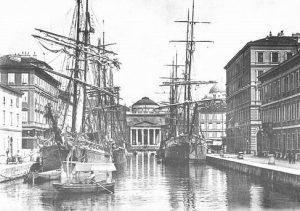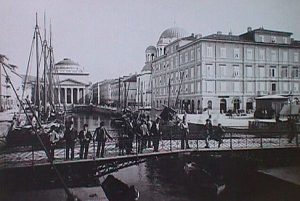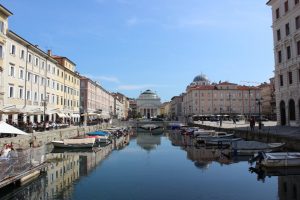Il Canal Grande era un corso di acqua marina poco profondo utile per le saline adiacenti che erano tagliate da tre canali, il “Canal piccolo” anche chiamato “Canal del vino”, che arrivava fino in piazza Vecchia, il “Canal maestro”, che divenne l’attuale Canal Grande lungo sino a lambire la chiesa di Sant’Antonio e un terzo, che arrivava fino a via Ghega. A quel tempo le saline erano una delle principali fonti di reddito della città.
Nel 1754-1756, per sviluppare l’area urbanistica della città all’esterno delle mura, fu progettato il Borgo Teresiano, con un impianto a scacchiera, formato da isolati regolari alternati a canali funzionali al carico e scarico merci. Quindi furono autorizzati i lavori del veneziano Matteo Pirona il cui progetto era di realizzare un canale grande attraverso l’interramento delle saline e lo scavo ulteriore del collettore principale.Ma il capitano napoletano Caracciolo portò a termine il grande progetto: allargò il corso d’acqua e rivestì in pietra naturale le nuove fiancate, scavò più in profondità e la terra asportata servì per livellare lo spazio davanti all’attuale Chiesa di S.Antonio Nuovo dando origine alla Piazza del Ponte Rosso. Fu istituito sul Canale un corpo di guardia per difendere i magazzini da eventuali attacchi della Repubblica veneziana , che mal vedeva il sorgere di una possibile concorrenza commerciale sullo stesso mare di esclusivo suo dominio.Successivamente vennero demoliti gli edifici fatiscenti che si affacciavano sul canale e sostituiti da case di due piani con possibilità nel tempo di sopraelevare altri piani.Il piano terra era dedicato ai grandi magazzini ed empori di ogni genere di merci e i piani superiori alle residenze private.
Il Canal Grande, lungo 370 metri e largo 28, venne completato nel 1756 e il costo si aggirò attorno ai 90.000 fiorini. Nel 1756 a metà del Canale per congiungere le due opposte rive fu costruito, prima in legno, “Ponte Rosso”, tinteggiato di rosso, da cui prende il nome il ponte e la piazza adiacente, e, successivamente, nel 1832, sostituito con uno in ferro con l’apertura in centro in modo da renderlo movibile e apribile. Nel 1827 per congiungere la Riva Carciotti (oggi III Novembre) con l’altra sponda del Canale fu costruito il Ponte Verde, chiamato così per il colore che assunse e ogni giorno veniva aperto per far accedere i bastimenti nel cuore della città. 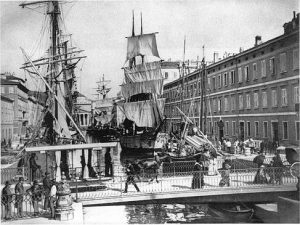 Nel 1904, per facilitare la maggior libertà di movimento della linea ferroviaria congiungente la Stazione Centrale con quella di S.Andrea, detta poi di Campo Marzio, fu costruito un terzo ponte, che i cittadini battezzarono col nome di “Ponte Bianco” e mentre su questo si riversava il tracciato ferroviario, sul vicino Ponte Verde passavano le rotaie del tram elettrico. Dopo la seconda guerra mondiale i due ponti scomparvero per lasciar posto ad un unico grande passaggio in pietra che univa la Riva con il Corso Cavour. Nel 1934 per congiungere via San Spiridione con Via Filzi anzicchè costruire un nuovo ponte s’interrò tutta la parte ultima del Canale con le macerie derivanti dalla demolizione della città vecchia, ricavando così l’attuale piazza Sant’Antonio.
Nel 1904, per facilitare la maggior libertà di movimento della linea ferroviaria congiungente la Stazione Centrale con quella di S.Andrea, detta poi di Campo Marzio, fu costruito un terzo ponte, che i cittadini battezzarono col nome di “Ponte Bianco” e mentre su questo si riversava il tracciato ferroviario, sul vicino Ponte Verde passavano le rotaie del tram elettrico. Dopo la seconda guerra mondiale i due ponti scomparvero per lasciar posto ad un unico grande passaggio in pietra che univa la Riva con il Corso Cavour. Nel 1934 per congiungere via San Spiridione con Via Filzi anzicchè costruire un nuovo ponte s’interrò tutta la parte ultima del Canale con le macerie derivanti dalla demolizione della città vecchia, ricavando così l’attuale piazza Sant’Antonio.
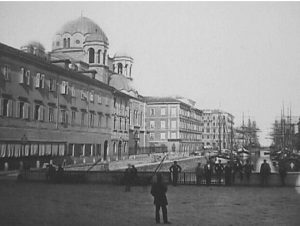 Si racconta che nel 1917 due piccole navi torpediniere,appartenenti alla Marina da guerra austriaca,vennero ormeggiate nel Canale di Ponterosso.Quando finì la grande guerra delle due navi ne rimase solo una,con vari problemi allo scafo ed al motore che era in avaria.Per molti anni fu oggetto di gioco per tanti i ragazzini dell’epoca che ci salivano sopra e l’avevano soprannominata “el sotomarìn”. Tra gli anni 1930-1932 la prima parte del Canale venne interrata e la torpediniera venne interrata con materiale edile derivante da alcune demolizioni di vecchie case di città vecchia….
Si racconta che nel 1917 due piccole navi torpediniere,appartenenti alla Marina da guerra austriaca,vennero ormeggiate nel Canale di Ponterosso.Quando finì la grande guerra delle due navi ne rimase solo una,con vari problemi allo scafo ed al motore che era in avaria.Per molti anni fu oggetto di gioco per tanti i ragazzini dell’epoca che ci salivano sopra e l’avevano soprannominata “el sotomarìn”. Tra gli anni 1930-1932 la prima parte del Canale venne interrata e la torpediniera venne interrata con materiale edile derivante da alcune demolizioni di vecchie case di città vecchia….
Oggi il Canal Grande è uno dei luoghi più amati dai triestini e dai turisti. Ristoranti e caffetterie si susseguono lungo le rive del canale offrendo le specialità eno-gastronomiche della città


